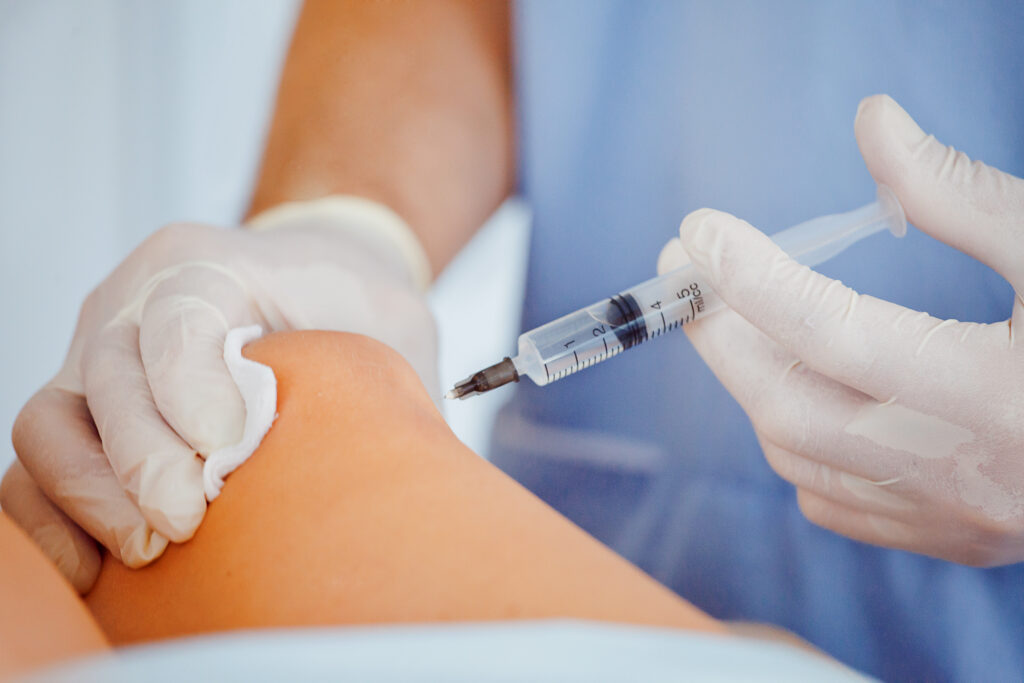Cortisone injections are commonly used to treat inflammation, joint pain, and allergy symptoms in specific body areas because they provide fast effective relief. What many sufferers of these ailments don’t consider is that there are cortisone injection side effects.
The side effects of cortisone – a steroid hormone that suppresses the immune system – can be horrible, causing significant discomfort and diminishing quality of life. Then, of course, there are also the side effects and risks of needles repeatedly piercing the skin.
Read on for 13 awful side effects that cortisone injections can cause…
Weight Gain

One of cortisone injections’ most common and unfortunate side effects is weight gain. That weight gain can be considerable if a person receives shots regularly over a long period of time.
Normally, when a patient receives cortisone steroid therapy, they are recommended to eat healthily, consume fewer calories, and exercise daily to prevent substantial weight gain.
Mood Swings

Cortisone and corticosteroids have been found to cause mood changes in some people. While these changes are typically mild, they can sometimes be severe, especially with high drug doses.
Mood-related side effects that cortisone injections may cause include anxiety, irritability, and difficulty concentrating. In severe cases, there may be paranoia, delusions, and depression.
Infections

Injecting cortisone (or any other drug or medication) can lead to infection. Injections are administered by piercing the skin. This makes it possible for bacteria and other germs to enter the body.
Antibiotic resistance is a serious and growing problem around the world. Thus, people with compromised immune systems are advised to avoid getting injections unless absolutely necessary.
Bruising

Bruising is a possible side effect of all needle injections. When injecting cortisone, though, the risk of bruising is higher due to the pharmacology of the drug or the way it works inside the body.
Corticosteroids like cortisone promote blood flow stimulation. This generally makes bruising more likely, as well as more visible. It can even lead to subcutaneous bleeding under the skin.
Insomnia

Classic insomnia symptoms are an incredibly common side effect of cortisone. In some research studies, as many as half of the participants on the drug reported experiencing them to some degree.
Cortisone tends to act fast and stimulates the adrenal/suprarenal glands, which produce adrenaline. When too much adrenaline is produced, sleeplessness and restlessness can occur.
Pain and Inflammation

Medical doctors commonly prescribe cortisone injections for treating inflammation and joint pain from arthritis, orthopedic injuries, and other health issues. However, the shots aren’t always helpful.
In a small percentage of people with these problems, cortisone increases pain and inflammation rather than relieving it. That is, their bodies have an adverse reaction, making their ailments worse.
Skin Issues

To the dismay of many, rashes, acne, and skin problems are cortisone injection side effects. As a matter of fact, bad skin used to be a major indicator that a professional athlete was using steroids.
Skin issues can affect any part of the body when undergoing cortisone therapy. When it is acne, it will typically show up on the chest and arms. It can also show up on the back, neck, and face.
Osteoporosis or Osteonecrosis

In some people, particularly women, cortisone injections can cause osteoporosis (bone weakening) or even osteonecrosis (bone death). The higher the dose and dose frequency, the higher the risk.
Unfortunately, most men and women who need cortisone treatment are elderly or middle-aged, so bone deterioration is already. Cortisone can speed up this natural process significantly.
Nerve Damage

Although relatively rare, damage to the nerves is among the serious side effects of regular cortisone injections. It can cause various health complications and unpleasant symptoms.
Most people receive cortisone shots in the joints, which are rich with nerves. Injecting them always poses a health risk. Symptoms of nerve damage include pain, numbness, and paralysis.
Profuse Sweating

Hyperhidrosis, or excessive sweating, is a disorder that cortisone therapy can cause that generally produces unhappiness in the form of inconvenience, discomfort, and embarrassment.
This condition causes excessive sweating to the point where moisture may drip from the hands, face, or other body parts for no apparent reason when the sweat glands do not function properly.
Headaches

Headaches and migraines can result from cortisone injections when the shots are administered to areas close to or associated with the brain, such as the head, the neck, the spine, or the shoulders.
Patients with arthritis and inflammatory conditions often get injected with cortisone in these sites for lasting relief. Regrettably, frequent headaches are one of many cortisone injection side effects.
Dizziness

Dizziness is another side effect that can affect people receiving cortisone injections in areas near or connected to the brain. It can occur with headaches and nausea.
In those that experience these symptoms, the side effects can be mild or severe. When dizziness is severe, persistent, and accompanied by other symptoms, professional help should be sought.
Cortisone Allergy

Like with other medications, it is possible to have an allergic reaction with cortisone injections. When this happens, disturbing symptoms may occur. Reactions can rarely be anaphylactic.
Anaphylaxis is a severe, potentially life-threatening allergic reaction that occurs suddenly. It can cause hives, shortness of breath, stomach pain, or swelling of the face, lips, tongue, or throat.







